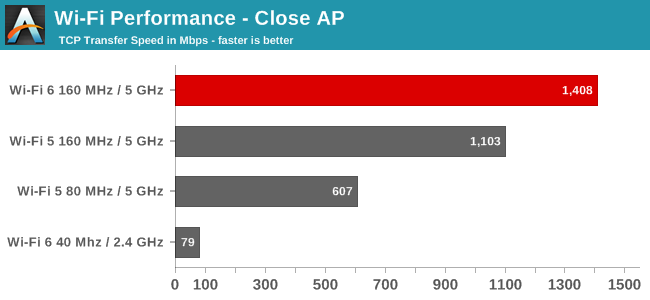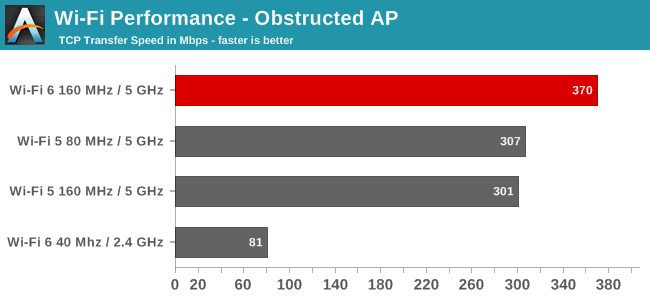AT 101: Wi-Fi 6 And Why You Want It
by Brett Howse on February 12, 2020 8:00 AM ESTPerformance
In order to achieve maximum performance, the latest Wi-Fi 6 standard leverages 1024-level QAM, but depending on the signal strength and quality it will scale down as needed, so to achieve the best performance very high signal to noise ratios are going to be required. Since 5 GHz is attenuated dramatically when it has to go through walls, if you need maximum Wi-Fi performance be aware that you are going to want your wireless router as close to the end device as possible. Luckily that is not an issue in our case, since the router is in the same room when testing for maximum performance, but we’ll also evaluate it in less than ideal scenarios as well.
Wi-Fi 5 vs Wi-Fi 6 – Close AP
First up we’ll test the TCP performance when the Access Point is in the same room as the client.

The performance advantages of Wi-Fi 6 are clear. With the access point in the same room, the SNR is very good and the new 802.11ax standard can really shine. With 1024 QAM and 160 MHz channels, the performance is over twice as fast as the outgoing Wi-Fi 5 with 256 QAM and 80 MHz channels. It is very impressive to see a typical 2x2:2 connection well over the Gigabit barrier, and even though the AX200 network card is the first generation, Intel has already done a fantastic job tuning it. The theoretical maximum transfer rate with 160 MHz channels and 1024 QAM is around 1200 Mbps per connection, so a 2x2 can in theory hit around 2.4 Gbps, meaning there's still room for improvement. Since 802.11ax also can be used on the 2.4 GHz frequency, unlike 802.11ac, the same test was also done on 2.4 GHz, and the results were disappointing. 2.4 GHz can still offer 40 MHz channels, but it doesn’t seem like the AX200 could take advantage of any of that. For reference, the wireless adapter in the laptop was reporting -21 dBm, which is a strong signal, which makes sense since the AP is almost right next to the laptop.
Wi-Fi 5 vs Wi-Fi 6 – Reduced Signal
Moving the laptop further away, and adding several walls and doors in the way to attenuate the signal, the same scenarios were again tested.

With some walls in the way, 5 GHz gets attenuated quite dramatically, and the SNR in the second location was -78 dBm. With such a low signal, the Wi-Fi 6 connection wasn’t able to take advantage of the 1024-level QAM and would have had to drop down to a much lower set, reducing the number of bits per tone, and even though the total channel bandwidth was still 160 MHz, it was only marginally faster on 802.11ax than 802.11ac 80 MHz. 2.4 GHz is not as impacted by walls, and as such was able to maintain the same transfer rate, even though it was still quite a bit slower.
So the results are clear. Wi-Fi 6 can offer a significantly higher level of throughput than Wi-Fi 5, but in order to do so, it needs a strong signal. The Wi-Fi 6 still outperformed the Wi-Fi 5 in the second test with an attenuated signal, but the performance gain was minimal. 2.4 GHz still offers the best signal strength, and therefore would be able to connect further away, and through more obstacles, but doesn’t offer anywhere near the performance of the 5 GHz range. It will be interesting to see the Wi-Fi 6E devices with 6 GHz support when they launch. It will open up Wi-Fi to a wider set of frequency choices, but will offer even less range.










149 Comments
View All Comments
evilspoons - Wednesday, February 12, 2020 - link
Ubiquiti devices work as normal routers. You take your normal internet connection, wired ethernet coming out of your modem, and plug it into the WAN port of the Ubiquiti router.nathanddrews - Friday, February 14, 2020 - link
I run a custom pfSense router/firewall/gateway, so it would run as an AP only. It's incredible how terrible most consumer/prosumer routers are compared to a pfSense install on basic hardware.Xyler94 - Wednesday, February 12, 2020 - link
Most if not all?Most home routers don't have the interfaces to link directly into the feed, nor the proper security creds to get connections, but more often than not, their modem can be configured in Bridge Mode, which then the modem acts as the bridge between your network and the ISP network. The modem turns off all routing and NAT features, and basically hopes the router next to it does that work. I recently configured mine in Bridge Mode because I now have a Fortinet Firewall.
gobaers - Wednesday, February 12, 2020 - link
Yep, this. I refuse to allow the ISP to have a device on my internal network, they are and should remain dumb pipes.Makaveli - Wednesday, February 12, 2020 - link
I do this on Fiber.ISP provider modem/router is in the closet.
Router Asus AX88U using a Media converter.
Bell Canada uses GPON
So Fiber going directly into media converter then Ethernet from converter to Asus router and its runs great.
Dug - Wednesday, February 12, 2020 - link
OFDMA isn't necessarily broken, it's a compatibility issue though. This is from Tim on smbforums."But the larger problem appears to be compatibility problems with older legacy devices that have not had driver updates. Some devices don't understand the new information in beacon frames, so they either don't associate at all or don't stay associated.
There are more problems with 2.4 GHz devices than 5 GHz, but both bands have problems. Routers makers are very reluctant to enable OFDMA and break their customers' Wi-Fi."
So it looks as though OFDMA could work, but by doing so it may reduce the devices that can connect if you have older devices. I've seen this commented before from others that have done testing.
DanNeely - Wednesday, February 12, 2020 - link
If the issue is drivers for legacy devices, I suspect the only work around on time scales shorter than the next decade (or longer if some OEMs can save a penny/unit by using a crappy chipset that doesn't support it) will be to run 2 parallel 5/6 ghz wireless connections (one with and one without) similar to how we currently run both 2.4 and 5ghz service; one for the legacy devices that will never be updated and one for modern hardware.Whiteknight2020 - Wednesday, February 12, 2020 - link
Well, according to that link there are some that do, Asus ax88 for one (on 5ghz).Makaveli - Wednesday, February 12, 2020 - link
What is your definition of True OFDMA.The article you posted which I've already read since i'm a member of the SNB forum.
Shows its enabled on the AX88U but only on the 5Ghz. Which would be fine for me as I don't use 2.4ghz for anything.
Ryan Smith - Wednesday, February 12, 2020 - link
Funny enough, Asus just finally turned on OFDMA support in the GT-AX11000 in the latest firmware, which was released last month. So that landed just as we got the hardware.